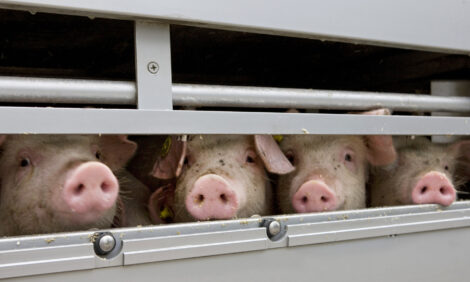



CME: Livestock Futures Meltdown Continues
US - The recent meltdown of livestock futures markets continued – and even accelerated – earlier this week, write Steve Meyer and Len Steiner.CME Group Lean Hogs contracts through October closed down the allowable $3.00/cwt daily limit and Live Cattle contracts through next June declined by $1.35 to $2.00/cwt.
Perhaps more ominous is the penetration by all LH contracts through August of key support established back in mid March. The June LH chart appears below. The 3 May close of $94.475/cwt was just over $9 per cwt lower than the close on Wednesday 20 April. The October and December contracts remain above the mid-March support levels but have lost roughly $6 and $5/cwt, respectively, over that same time period. Those declines translate into anywhere from $10 to $20 per head of lost potential value for pork producers.

The June Live Cattle chart looks much the same as the Lean Hogs contracts. The 3 May close of $110.60 is the lowest since 11 January and also penetrates the support established in mid- March. The good news is that no other Live Cattle contract has broken its respective support level yet. But the patter of the past few weeks is not encouraging.

What has driven this huge sell-off in livestock futures? There are a number of important factors:
- Some reckoning between the actual demand levels for meats and the demand levels being traded by the futures markets. While actual demands for pork, beef and chicken have been very good since last summer, these futures markets have been trading stupendous demand levels since that time! Forecast percentage changes in production and percentage changes in prices implied by futures markets have implied price flexibilities (percent change in price divided by percent change in quantity = the inverse of the elasticity of demand) in the 10 to 20 range for much of the year. Those are far beyond the normal relationships of anywhere from 3:1 to 5:1, implying that traders expected demand curves to be much higher than last year.
- A general unwinding of long speculative interests in commodities. We list this primarily out of duty since the position has scant support when one considers the charts of most other commodities. Grains have softened since the beginning of 2011 but have not fallen as sharply as have livestock futures in recent weeks. Crude oil has had its ups and downs but futures prices reached their highest levels since 2008 last week. Gold is at record levels. Copper is off its January highs but still 40 per cent higher than one year ago. If waning spec interest is indeed a factor, it appears to be focused on these livestock contracts so can that really be a factor?
- An actual decline in consumer demand levels in both absolute and expected terms. This one has legs, we think. Chicken prices have not risen, making that product cheap relative to record-high beef and near record-high pork. That should be a drag on demand. High gasoline prices have depleted disposable incomes, very likely reducing meat expenditures at both retail and food-service. The cold spring has very likely delayed the grilling season, reducing the size of the normal spring demand increase. Finally, this year' late Easter likely kept attention on seasonal meats much longer than normal, delaying consumers' normal spring purchases. This argument may be overdone but can spring really arrive until Easter has passed? Apparently not.
- Some softening of exports, especially for pork. Korea, though still active, is not nearly the driver it was in January and February having rebuilt its domestic inventories to some degree. And high prices impact the quantity demanded by export markets as well!








